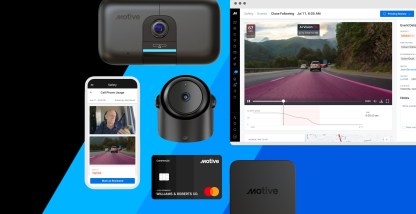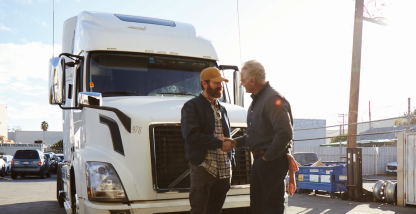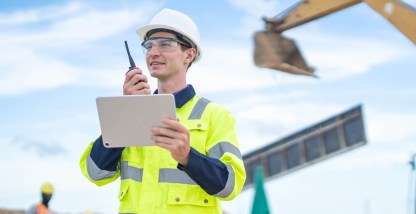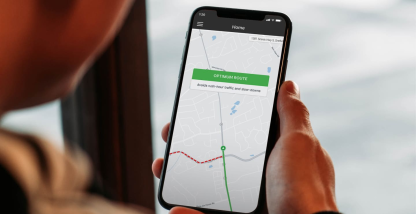Among the seemingly too many changes to count, the COVID-19 pandemic has precipitated a profound shift in consumer buying habits.
As physical stores closed either temporarily or for good due to government mandates or consumers’ hesitancy to shop in-person, IBM’s U.S. Retail Index noted that the pandemic accelerated the shift away from shopping in brick and mortar stores to digital shopping by about five years.
These changes in consumer behavior combined with the acceleration of digital transformation put pressure on the supply chain and especially last-mile delivery — a large area of concern for fleet managers due to a number of factors we’ll discuss in-depth in this article.
In addition to what last-mile delivery is and why it’s so important, we’ll discuss how to improve last-mile delivery costs and logistics, as well as how emerging technologies can play a big role in your last-mile delivery operations.
What is last-mile delivery?
Last-mile delivery refers to the final destination in the supply chain, when a product transfers from a business (typically a retail store, warehouse, or distribution center) to the customer’s business or home.
Last-mile delivery might sound simple, but it’s actually the most difficult step of the whole shipping process. From the placement of an order to the successful arrival of the package at its final destination, a lot happens. Last-mile delivery is an important final step in this long chain of events.
Why is last-mile tracking so important?
Last-mile delivery is a customer-facing process that requires extreme coordination and represents an integral interaction between the buyer and the seller. The rapid growth of the eCommerce industry, accelerated due to the pandemic, has increased demand for flexible, fast, traceable, and personalized last-mile delivery. Customers want to know exactly where their items are, and when exactly they can expect them.
If last mile tracking information is incorrect, a product arrives late, is damaged, or is never delivered, there’s a good chance that the customer will shop with a competitor next time.
These aspects of last-mile tracking and last-mile delivery are most important to customers:
- Fast delivery: Possibly most important of all, customers want speed. Fifty-two percent of customers expect a refund or discount on shipping costs if delivery is delayed.
- Delivery tracking: Delivery tracking is high on the list of consumer demands. It’s a feature that increases convenience. Precise fleet asset tracking is necessary in today’s tech-focused world.
- Security: Throughout this final stage of delivery, customers want their goods to be safe and secure. Security needs to be guaranteed, and insurance should be offered when placing orders to cover any potential mishaps.
- Convenience: Last-mile delivery shouldn’t require any special effort from the consumer. Once the order has been placed, delivery should be a convenient and seamless process that follows. Customers have no desire to put in additional effort to ensure they receive their orders.
- Specialization: Scheduling and routing options are critical. Fifty-five percent of customers need to reschedule appointment windows at least 20% of the time and 70% expect to be able to make some kind of routing change, whether to a new address, terminal, or pickup locker.
- Cost of delivery: Sixty-two percent of customers cite cost as the most important factor in delivery.
Understanding last-mile delivery costs
Last-mile delivery problems are the most expensive part of the supply chain, accounting for 40-50% of total shipping costs. The total shipping costs add up for delivery organizations when you think of everything that goes into these deliveries: people, vehicles, and management.
A number of factors contribute to last-mile delivery costs, including:
- Fuel costs: Fuel costs have a huge impact on the price of a truckload. Higher prices and fuel shortages are the second largest operating cost on average behind the truck driver.
- Idling and downtime: There’s a lot of idling when drivers are driving and dropping off goods in cities. Drivers are dealing with other vehicles, traffic, and winding streets on a daily basis. A delivery truck, on average, uses around 0.8 gallons of fuel per hour when idling, which can add up quickly.
- Out-of-route miles: Drivers tend to lose track of their dispatchers’ route plans given the high number of individual stops they make, especially if those routes aren’t easy to refer back to. Unfortunately for shippers, a study shows that out-of-route miles usually account for 10% of the overall delivery fleet’s mileage.
- Warehousing: The amount of space, storage characteristics, geographic location, and total number of locations can impact the cost.
- Failed deliveries: Companies that distribute goods to supply chain partners or delivery hubs don’t have to deal with failed deliveries. In contrast, businesses that deliver to the end consumer are grappling with the problem of failed deliveries every day. Even a single digit percentage of failed deliveries (and the industry average is around 5%) can add up to considerable costs quite rapidly.
How to improve last-mile logistics
The focus of last-mile logistics is to deliver items to the end consumer as fast as possible. While it seems simple enough, the last mile is an expensive mile. The following tips can help you improve last-mile logistics and cut costs.
Use route planning
A poorly planned final delivery will never reach its destination on time. But with a good route optimization solution, last-mile deliveries can be done faster than usual. The delivery routes are optimized considering the traffic, road conditions, distance, vehicle type, and vehicle capacity.
Consider requiring proof of delivery
Proof of delivery verifies that the delivery has been made successfully. Drivers can easily finish capturing proof of delivery and add it to their daily report of deliveries. It removes any confusion and can prevent or reduce the number of false claims.
Analyze your reports
Daily reporting of deliveries can help companies understand how deliveries are being carried out. By analyzing reports, businesses can identify weaknesses and create opportunities for improvements in the last mile. Motive can help monitor key metrics while filtering out data by drivers, date, or route.
Understand the importance of customer experience
By properly planning for last-mile logistics, you can keep your customers happy. Making meaningful improvements to your customer communications requires going beyond providing customers with a static tracking number. Make the last mile options flexible, allowing the customer to customize the experience to best suit their needs.
Use dispatching software
Last-mile delivery software simplifies managing, dispatching, and optimizing last-mile delivery logistics. When using a real-time fleet tracking solution, you’ll see predictive arrival times, have a real-time view of driver locations, and be able to better plan routes and assign new deliveries to drivers as they come in.
How to use Motive to solve last-mile delivery challenges
Motive’s comprehensive fleet workflow solution is proven to save time and money, two crucial factors in having the most efficient last-mile delivery as possible. Solving last-mile delivery challenges begins with cutting costs, an easy task with Motive’s fleet management system, which helps increase profits by:
- Reducing fuel usage
- Increasing customer retention
- Minimizing vehicle breakdowns
- Preventing collisions
- Controlling overhead
Fleet-based businesses can use vehicle tracking software like Motive to improve last-mile delivery, including improving the customer experience, streamlining processes, and controlling and reducing operating costs.
Request a free demo today to see how Motive’s best-in-class fleet management software can help you improve last-mile delivery.









